GPSC Prelims Paper 1 Mock Test - 2 - GPSC (Gujarat) MCQ
30 Questions MCQ Test - GPSC Prelims Paper 1 Mock Test - 2
Consider the following pairs :
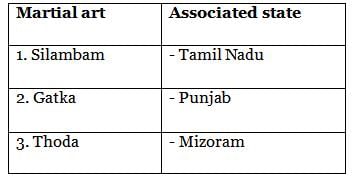
Which of the pairs given above is/are correctly matched?

Which of the pairs given above is/are correctly matched?
In the context of medieval India, the 'batai' and 'nasaq' were
With reference to the Rashtrakuta dynasty, consider the following statements:
1. The rulers of the dynasty were strict followers of Shaivism and prohibited the practice of any other religion.
2. Krishna I of the Rashtrakuta dynasty built the Kailasha temple dedicated to Lord Shiv at Ellora.
Which of the statements given above is/are correct?
1. The rulers of the dynasty were strict followers of Shaivism and prohibited the practice of any other religion.
2. Krishna I of the Rashtrakuta dynasty built the Kailasha temple dedicated to Lord Shiv at Ellora.
Which of the statements given above is/are correct?
Consider the following pairs:
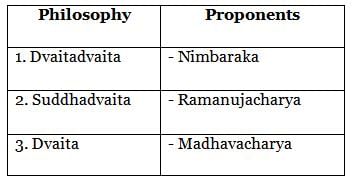
Which of the pairs given above is/are correctly matched?
The rock shelters on the banks of the River Suyal at Lakhudiyar, Uttarakhand, bear prehistoric paintings. In this context, which of the following are the characteristics of the Lakhudiyar cave paintings?
1. Hand-linked dancing human figures
2. Absence of animal motifs
3. Humans represented in a stick-like form
4. Use of only white and black colors
Select the correct answer using the code given below.
Consider the following events in Indian History:
1. Ahmad Nagar in the Deccan had declared independence under Malik Ambar
2. Englishmen got consent to establish an English factory in India
3. Mughals captured Golkonda by defeating Abul Hasan
Which of the above events happened during the reign of Jahangir ?
With reference to Mughals architecture, the marble tomb of Rabia ud daurani was built during thereign of :
Consider the following pairs with reference to the Mughals administration :
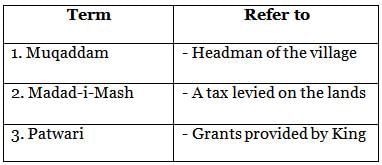
Which of the pairs given above is/are correctly matched ?
Who among the following is the author of the Hastyayurveda ?
Consider the following statements :
1. It is the capital city of the Ghauri Dynasty, founded by Hoshang Shah.
2. It is a typical representation of the medieval provincial style of art and architecture.
3. The Hindola Mahal, which looks like a railway viaduct bridge, is located here.
The above statements are about ?
In the context of the economic conditions of the Gupta Empire, consider the following statements:
1. The period witnessed an increase in taxes on trade and commerce, while the land taxes were decreased.
2. Villagers were subjected to forced labor by the royal army and officials.
3. Daily transactions by the people residing in the empire were done through the dinars (gold coins).
Which of the statements given above is/are correct?
Consider the following statements with respect to Mahayana Buddhism:
1. Its ultimate goal is 'spiritual upliftment'.
2. The school is more liberal and believes in the heavenliness of Buddha.
3. Its scholars predominantly used Pali as a language.
4. Emperor Kanishka patronized the Mahayana sect of Buddhism.
Which of the statements given above are correct?
In the context of medieval India, the Tulugma System of warfare was used by
Consider the following statements with reference to the Maratha Administration :
1. Walkia-Nawis maintained the records of the king’s activities and the proceedings in the court
2. Summant was responsible for civil and military justice
3. Sari Naubat was in charge of religion, ceremonies and charities
Which of the statements given above is/are correct ?
Which one of the following is the correct chronological order of the later Mughal rulers ?
Consider the following pairs :
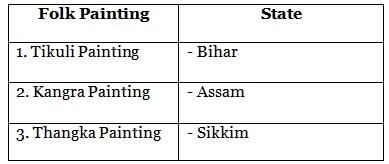
How many pairs given above is/are correctly matched ?
Consider the following statements :
1. Thang Ta is the exclusive martial dance form of Sikkim.
2. Bhuta Aradhana is a ritualistic theatre of Karnataka.
3. Singhi Chham is a popular mask dance of Manipur.
Which of the statements given above is/are correct ?
Foreign traveler Visited during the reign of
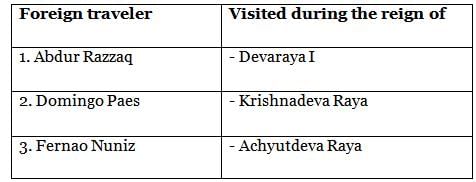
How many pairs given above is/are correctly matched ?
Consider the following statements with reference to the Coins of Indo-Greeks :
1. They followed an Indian weight standard
2. They had bilingual inscriptions in Greek and Kharoshthi
3. They contain motifs of religious symbols of Indian deities
Which of the statements given above is/are correct ?
Consider the following statements with reference to Kanishka :
1. His empire extended from Central Asia to north India and included Varanasi, Kaushambi and Sravasti in Uttar Pradesh.
2. He convened the fourth Buddhist Council at Purushpura.
3. The Buddhist scholar, Ashvaghosha lived in his court.
Which of the statements given above is/are correct ?
Which of the following are characteristics of Hindustani music:
Improvisations are not allowed.
Influenced by Persian music.
More emphasis on vocal music than on instruments.
Which of the statements given above is/are correct?
Consider the following statements regarding Chandragupta II:
He adopted the title of Vikramaditya.
His court at Ujjain was adorned by scholars like Kalidasa and Amarasimha.
Chinese pilgrim Fa-hsien visited India during his reign.
Which of the statements given above is/are correct?
Consider the following statements regarding Sakas
Saka ruler Vikramaditya established a pillar in Ujjain in 58 AD starting a new era called the ‘Vikrama Samvat’.
Saka ruler Rudradaman l constructed Sudarshan lake in the Kathiawar region.
Which of the statements given above is/are correct?
Consider the following statements regarding Gandhara and Mathura Art:
Gandhara art was influenced by Graeco-Roman style while Mathura Art was totally untouched by outer influence.
Matura Art produced several images of Mahavira Jain.
Which of the statements given above is/are correct?
Which of the following are members of the Shanghai Cooperation Organisation (SCO)?
Kazakhstan
Turkmenistan
Tajikistan
China
Select the correct answer using the code given below:
Which of the following statements is not correct:
Consider the statements regarding Satavahanas:
Satavahanas called themselves only Brahmana who defeated Sakas and Buddhist.
Nagarjunakonda and Amaravati become important Mahayana sites during Satavahana period.
Which of the statements given above is/are correct?
Consider the following statements
-
Chola, Chera and Pandya Kingdoms lay outside the territories of Mauryan empire.
-
Wealth of these states was mainly from overseas trade of cotton and spices.
-
All three kingdoms were patrons of Sangam literature.
Which of the statements given above is/are correct?
In the South Indian medieval history, there is a lot more known and recorded about Cholas than their predecessor. Which of the following can be reasons for it?
Chola courts housed several poets and authors who wrote about the kings and the kingdom.
Temples built by Chola kings have long inscriptions written on their wall about their victories.
Sangam literature gives detailed account of historical narratives of the king and the society of the time.
Travellers and traders visiting Chola empire have written extensive literature about the kingdom.
Select the correct answer using the code given below:
Consider the following statements regarding Madhubani Paintings:
Traditionally, these paintings are done by men only.
These are traditionally painted on walls.
These paintings are 2 dimensional.
Which of the statements given above is/are correct?














